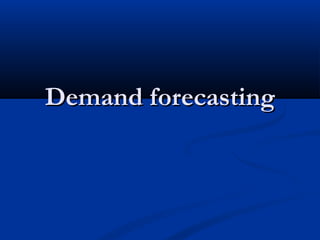
Lect. 8, chap 4 demand forecasting
- 2. General considerations Demand forecasting is very important for smooth/efficient functioning of any org. and even an economy as a whole. This forecasting becomes more important in advanced countries where demand conditions are more uncertain than supply conditions and where mostly S>D. As competition begins to intensify, demand forecasting assumes significance.
- 3. General considerations continued Six factors involved in demand forecasting: How far ahead: short-run ( unto one year), and long run( up to 5, 10 or 20 years). Short run can also mean operating within the limits of already available resources and long run means extending or reducing the limits of resources.
- 4. General considerations continued Three levels of demand forecasting: i) Macro level (economy as a whole), ii) micro level (industry) and, iii) firm level- imp. far managerial level. General vs. specific forecast : firms need specific product/area-wise forecasts. Problems and methods for new and old products vary as sales trends and competition characteristics are not available for new products.
- 5. General considerations contd. Distinctive patters of demand: Important to classify goods into categories like producers goods, consumers goods, services etc. Finally, special factors peculiar to each product and market must be taken into account. This involves psychological/ sociological considerations of people about the product and its future. It is the basis of branding.
- 6. Methods of forecasting: 1. Opinion survey No easy method or simple formula Opinion survey or Survey of buyers intensions usually for a year ahead. It is a passive method. It may turn out to be biased as respondents may not give realistic and rational responses. It is quite useful when bulk of the sales is made to industrial producers.
- 7. 2. Delphi method A variant of opinion poll. Attempts to involve large number of experts Questions them repeatedly till a consensus is arrived at among participating experts. The identities of different experts, especially holding contrary views are not revealed to avoid “halo effect” till there is consensus. Originally developed at Rand Corporation by Olaf Helmer, Dalkey and Gordopn in late 1940’s. Used successfully, especially for technological forecasting. But it assumes panelists to be rich in experience/ knowledge and objective in their analysis.
- 8. 3. Hunch method or Expert opinion Involves field experts like dealers, distributors and suppliers, officers of trade associations as also industry analysts, special marketing consultants etc. Collects their assessments and arrives at forecasting by applying varied statistical methods of analysis. A simple and quick method.
- 9. 4. Collective opinion/ sales-force polling Salesmen required to estimate expected sales in their respective territories/sections These estimates are reviewed to avoid biases of optimism and pessimism of salesmen The revised estimates further examined in the light of factors like proposed changes in prices, product designs, advertisement programs, expected changes in competition, changes in purchasing power, income distribution etc. Simple and based on first hand information. But subjective and relevant to short periods
- 10. 5. Naive models Based on historical observations of sales Ignores casual relationships of variables Consider Y as actual sale value and Y’ as forecast t t+1 value Three models: _ i) Y’t+1 = Yt , ii) Y’t+1=Yt +(Yt-Yt-1), iii) Y’t+1= Yt x (Yt / Yt-1). Consider the data below:
- 11. 1 2 3 4 5 6 7 8 9 10 11 12 Month 30 29 36 29 33 40 47 55 52 55 58 61 Monthly 50 80 70 10 40 60 50 10 80 04 10 00 sales of A in Rs. 000
- 12. 6. Smoothing techniques These techniques are a higher form of naïve models. Its typical forms are: a) moving averages and b) Exponential smoothing. Moving average are updated as new information is received. Exponential smoothing is popular for short run forecasting. It uses weighted average of past data as basis for forecast. Heavier weights are accorded to more recent information. It is effective when there is randomness and no seasonal fluctuations in data. The formula for exponential smoothing: Y’t+1= αYt +(1- α)Yt -1
- 13. 7. Analysis of time series and trend projections Firms, industry, and economy data available for some years are used in this analysis to forecast demand. A number of statistical tools are available for this analysis. The trend projections are also arrived at by analyzing the data with the help of statistical and graphic methods
- 14. 8. Use of economic indicators Construction contracts sanctioned for building materials, say cement Personal income for demand of consumer goods Agricultural income for the demand of agricultural inputs, implements, fertilizers etc. Automobile registration for car accessories/ petrol demand
- 15. 9- 10. Controlled experiments and judgmental approach Controlled experiments are undertaken by varying some variable while holding others constant. This method uses a host of statistical methods, especially the regression analysis Judgmental approach means using judgment to choose the method and tools for demand forecasting as per the specific product case
- 16. Engle’s Law of Consumption Dr. Engle was a German statistician. He made a study of family budgets around the middle of the nineteenth century He arrived at the following major conclusions: i) As income increases the percentage expenditure on food decreases and vice versa ii) The percentage expenditure on clothing, etc. remains more or less constant at all levels of income
- 17. Engle’s law……… iii) The percentage expenditure on fuel, light, rent, etc. also remains practically the same at all levels of income. iv) However, the percentage expenditure on what may be called comforts and luxuries of life increases with increase in income and vice versa.